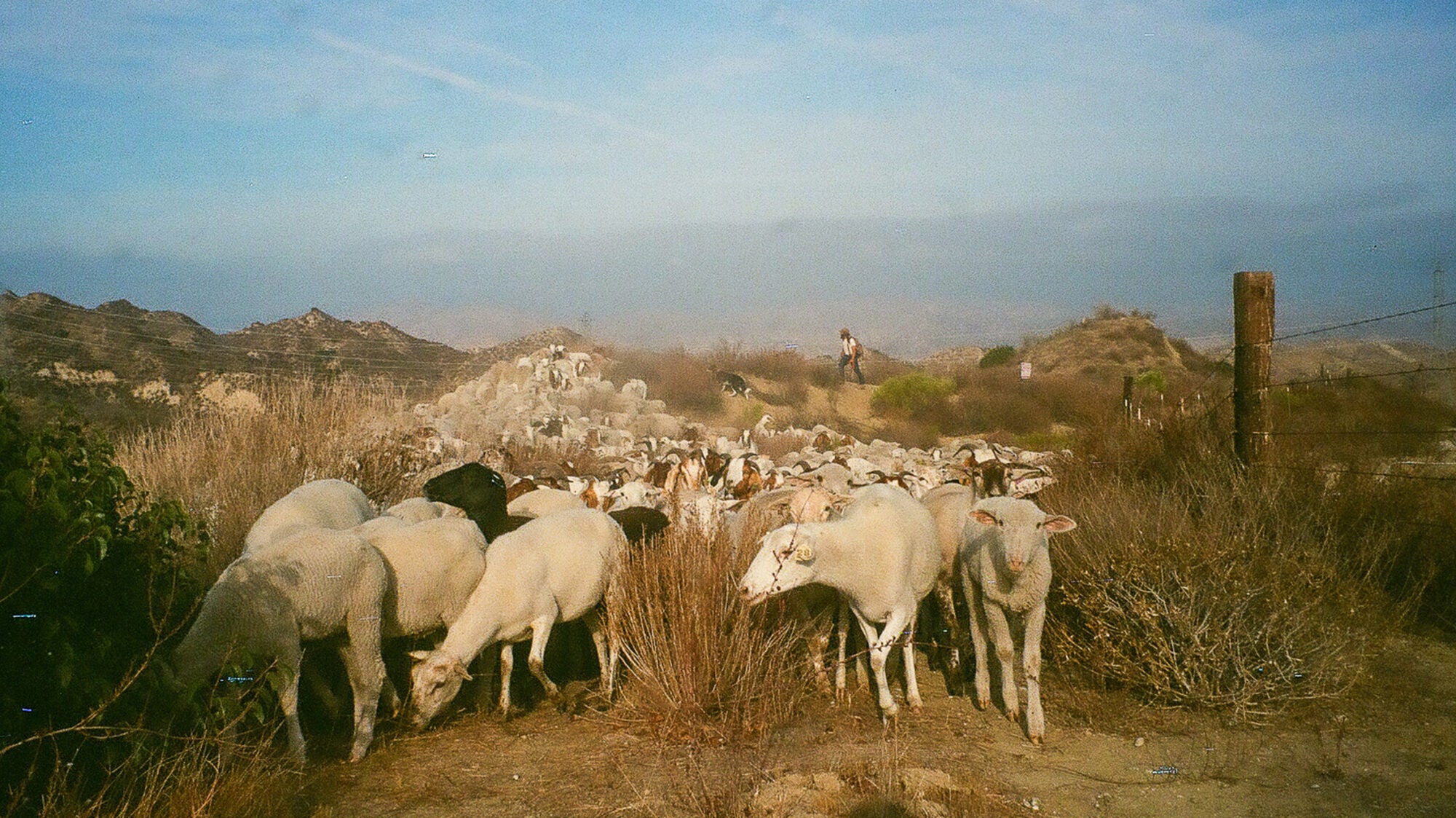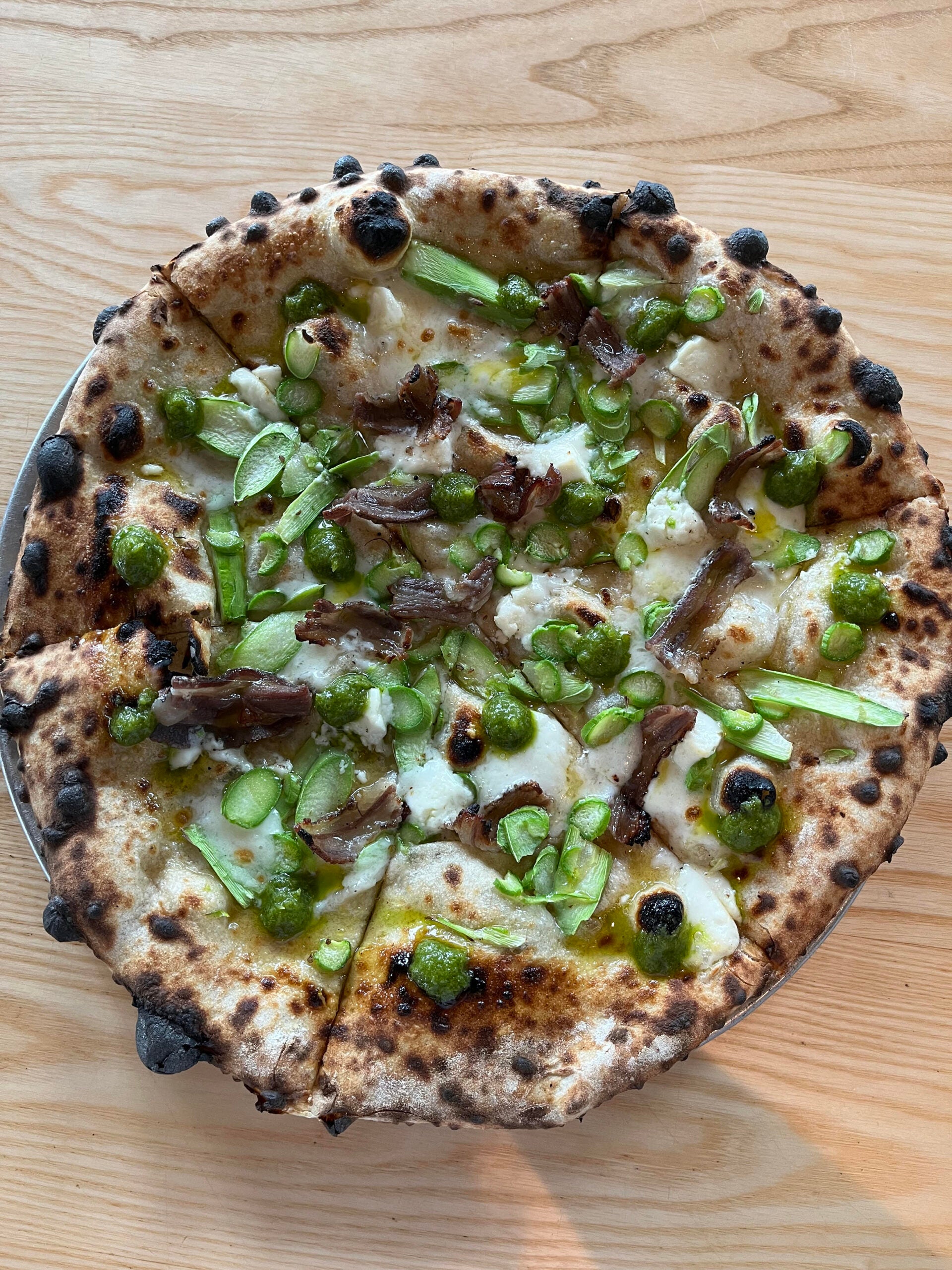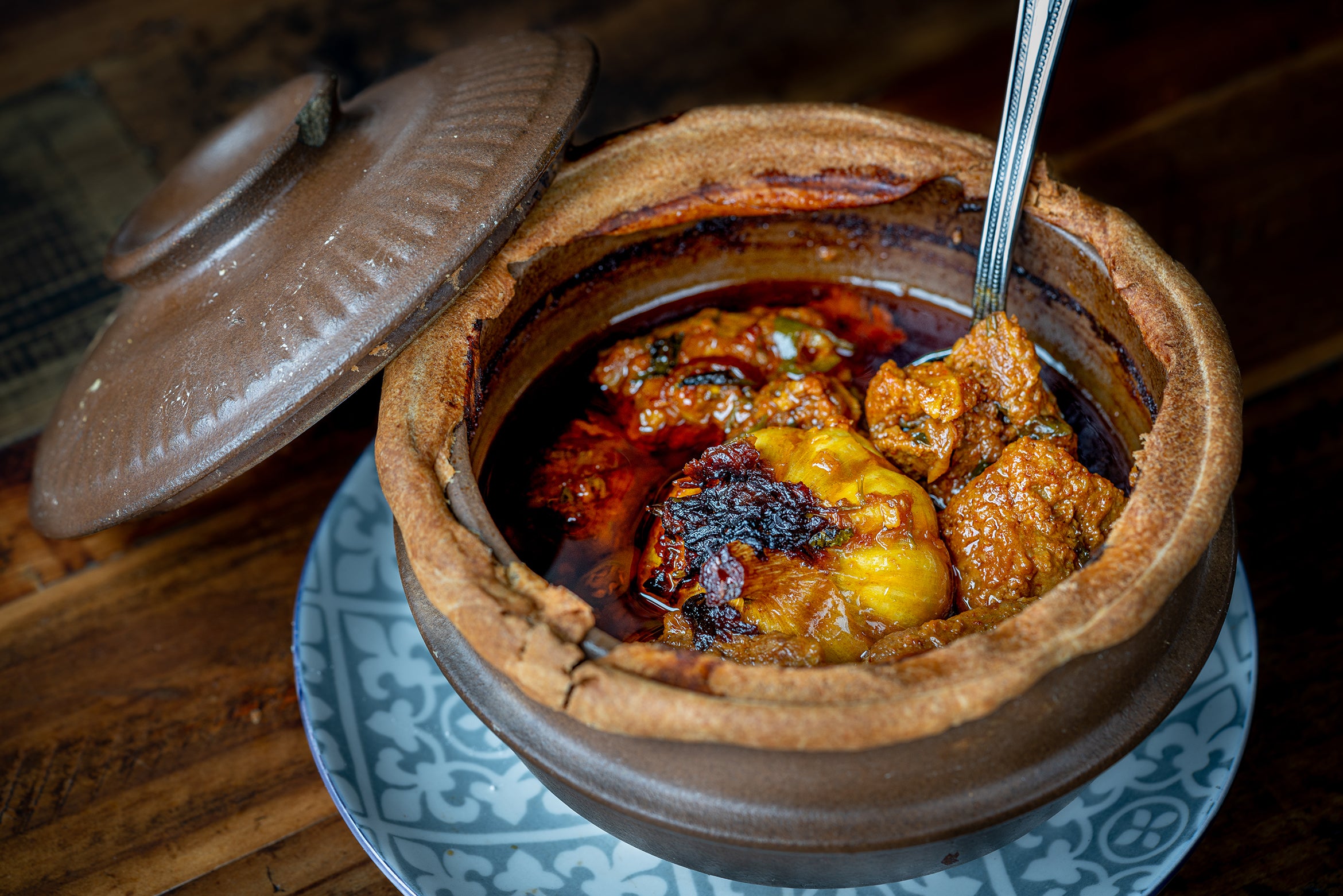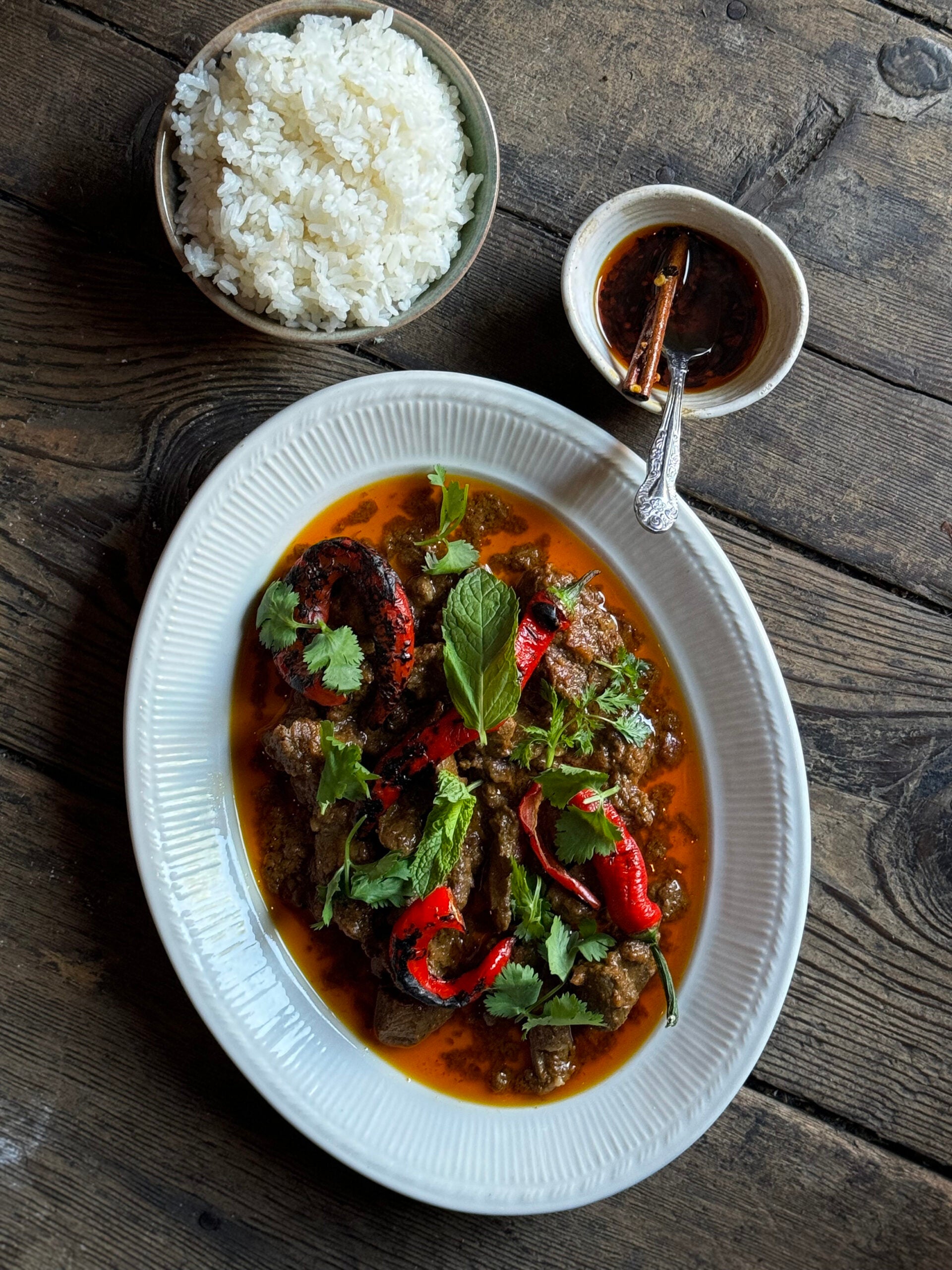
How shepherds and chefs are teaming up to revitalize the American sheep industry
Huddled together, Katahdin/Dorper sheep look like a batch of meringues. Wispier rather than woolier, they’re a short-haired breed. Dylan Boeken, a first-generation shepherd in Ojai Valley, lets his herd graze on Southern California’s wild pastures. They snack on whatever foods the land has to offer, from elderberries and oak to thistles and oats. On average, his sheep will eat 150 to 300 plant species during their lifetime. Boeken is there for most of it, raising 200 to 300 sheep per year. But he’s also there at the end. As head shepherd and butcher of Boek House Hearth & Husbandry, he has seen firsthand how letting sheep graze impacts flavor. “When you raise them on pasture, you really get the meat to express all the unique properties that animal comes with,” he says.
Boeken is among the newest generation of shepherds working to revive the American sheep industry, putting sustainability and innovation at the forefront.
“America’s first sheep” is a title belonging to the Navajo-Churro. The wooly breed became a part of the Southwest’s deserts in the mid-1500s by way of the Spaniards. Local communities, including the Navajo, or Diné, acquired a few of the fleecy creatures. Over time, breeding them in isolation, a new landrace sheep emerged that had acclimated to the extreme desert climate. Named the Navajo-Churro, honoring both sides of its lineage, the multipurpose animal has remained a staple for fiber and food ever since.
As more and more settlers arrived, so too did numbers and breeds of sheep. US Department of Agriculture reports note peak numbers in 1884, with 51 million sheep accounted for, and again in 1945, with 56 million. At this point, the meat of sheep—whether younger lamb or older mutton—was not the focus of farmers and ranchers. Instead, it was a by-product. It was the animals’ fleeced backs that turned a real profit, supporting the successful wool industry, a system that largely came to a halt after World War II as urbanization and industrialization pushed textile factories to embrace capitalism’s adjectives of “cheaper,” “faster,” and “more.” Newly invented synthetic fibers rose to prominence, replacing natural ones. Wool fell out of fashion, and so did lamb and mutton. Some who had been herding flocks turned toward animals that were deemed more profitable by the growing industrialized meat industry, such as cows, pigs, and chickens. Others left the work altogether.
Since then, imported lamb and mutton has come to fill culinary gaps caused by this slump in domestic sheep. According to the USDA, over half of all lamb and mutton bought and sold across the country today has been imported—mostly from Australia and New Zealand. The two oceanic countries produce around 610,000 tonnes of sheep per year, dominating the market not just in the United States but globally. Their higher exchange rates provide them an advantage in selling to supermarkets and distributors at lower prices—sometimes at half the cost of domestic counterparts. This savings in cost, however, is being paid elsewhere. “It’s not just that you lose a locally grown product, but you lose shepherds, ranchers, and farmers,” says Boeken of the dwindling domestic sheep market. “Raising sheep doesn’t just produce sheep, it also produces shepherds.”
Shepherds are leading the charge to return to eating US-grown sheep, with support from like-minded chefs. Follow the movement and you will come across some of the brightest and ecologically sound methods in shepherding and cookery.
Pinyon, a wood-fired pizzeria in Ojai, California, is one restaurant that has embraced its local shepherd: Boeken. Each year, the kitchen’s Something About Aries pizza makes its solar return. It’s usually around the end of March, but it’s always in alignment with the lambing season. (Shepherds are at their busiest from February through April, caring for pregnant ewes and then their newborn lambs.) House-made mozzarella and green garlic pesto are topped with Boeken’s sheep belly bacon, smoked and cured in house, and thrown together with any other seasonal flora that can be sourced from growers on California’s Central Coast. Sometimes it’s purple pea flowers; other times, spring asparagus. Always, it’s an homage to Mother Earth’s vernal offerings.

Sheep belly pizza at Pinyon
But for chef Jeremy Alben, the fleeting seasonal dish is also a reminder that we do not always need to be eating lamb, which must be under one year old, and that we should eat older sheep meat as well. “Sheep as a category of animal that we eat is a good thing to keep harping on—we should let those animals have fuller lives,” says Alben. Older meat like mutton, which is made from sheep that are a minimum of two years and a maximum of eight years old, sometimes has a stereotype of being too tough or gamy. This is quickly disproved by the legacy of slow-cooking mutton methods across the globe.
Wherever sheep have been raised for wool, you’ll find time-honored recipes for mutton. For communities with a shepherding past, eating older sheep meat ensured these animals did not go to waste, even after their fleeced backs were no longer of a quality to be sheared. From the Maghreb region of North Africa to Mongolia, braised and boiled mutton has been a mainstay protein in rice dishes and soups for millennia. In Mexico, mutton is cooked barbacoa-style and in parchment-barbecued mixiotes, where marinated sheep meat is often wrapped in maguey leaves and steamed before topping a tortilla. Dolloped with cilantro, salsa, nopales, and pineapple, woody and deeper-flavored mutton manifests into something floral and bright.
Earthier than lamb, mutton is a perfect match for botanical flavors. Chef Chintan Pandya of NYC’s Dhamaka knows this well. The restaurant originated from a desire to bring the forgotten side of Indian cuisine to eaters, and its Champaran meat dish pays homage to a traditional recipe from the East Indian state of Bihar. Here, marinated mutton is bundled up in an earthenware pot called a handi with a small field’s worth of mint, ginger, and chiles and a whole bulb of garlic. Dough is pinched around the edge of the vessel, securing the lid to accomplish maturing. Seen from above, the sealed handi resembles a solar eclipse, with the puffed baked bread making a ring of fire.

Champaran meat at Dhamaka. Photo by Paul McDonough
The dish, which is consistently sold out, is made in limited quantities due to resources. “I had no clue it would be so difficult to find mutton in the Northeast,” says Pandya. Finding the right local farmer to source directly from has taken him seven years. And, due to the lengthy search it required, he says, the exact name will be kept a secret.
When the legendary NYC steakhouse Keens first opened its doors in 1885, mutton was ubiquitous across the country—and appeared on the restaurant’s very first menu. Executive chef William Rodgers is carrying on the legacy of the kitchen’s 26-ounce mutton chop today. He’s seen diners make a pilgrimage to try the iconic dish, which is made from the saddle cut of whole pasture-raised sheep, purchased from Colorado and broken down in house. “I don’t care what anyone else says about [sheep] meat from Australia and New Zealand—for quality and taste, the difference between that and this is night and day,” says Rodgers.
Back in Ojai, Boeken continues moving his sheep from pasture to pasture, ensuring they never come back to the same plant and overgraze. He’s also expanding his network of restaurants to ensure his herd won’t go to waste, forming new partnerships with chefs like Saw Naing, of the apricot masala jam and urfa-spiced world of the Dutchess in Ojai. Naing purchases whole sheep to deploy in nose-to-tail cooking, simmering the meat in a lush chickpea curry, swaddling it in puff pastry beside basmati rice, or chucking it onto grilled skewers. Most recently, a mutton curry made with charred Jimmy Nardello peppers hit the menu. (Boeken sources his mutton from other farmers who are unable to find a market for the less popular style of sheep.) Rotating lamb and mutton in and out, one thing is certain: Boeken himself is kept in rotation.

Mutton Curry dish at The Dutchess
Such partnerships have made him hopeful for the future and for reviving the industry. “Even just one restaurant choosing to support local farmers has such a huge impact on a small ranch business,” he says. “If that is a regularly sized restaurant and they’re buying their product from a local farmer, that might be a significant chunk of what they need to make for the year, just through that one client. Every restaurant that signs on plays a huge role in creating the potential for local farming.”
When it comes to Boeken’s shepherding and butchering operation in particular, the decisions chefs have made to source meat from him is the sole thing that has allowed his business to flourish. This year, he will be expanding to sell local sheep in butcher shops across Southern California. Until then, he will continue leaning on the herd that helped get him there.